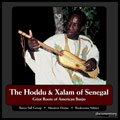The Hoddu & Xalam of Senegal
Griot Roots of American Banjo
About
Details: Audio CD, 2003, 15 Tracks, featuring Barou Sall Group, Massiren Drame, and Boukouta Ndiaye. Produced and Recorded by Alan Govenar.
Liner Notes
Along the coast of West Africa and throughout the Senegambia region of the savannah grasslands, are modern griots – traditional songsters who accompany themselves on plucked lutes. Each of the ethnic groups they represent has its own name for the music they perform; griot is a polyglot term introduced during the 17th century by French explorers who mimicked the local languages and names given to bards and songsters. Griots have traditionally been employed as court musicians, but have also specialized in work and praise music, sometimes associated with trades or guilds. Some have performed for farmers; some are itinerant.
Griots are often the keepers of a tribe’s oral history, which they chant or sing in epics accompanied by a solo instrument. Through the centuries, griots have played an abundance of stringed instruments, including fiddles, lutes and harps. In Senegal, the plucked lute, known as the xalam to the Wolof, as the hoddu to the Pulaar, and the gambere to the Soninke, appears to prefigure the American banjo. Piedmont blues songster John Dee Holeman, who accompanied to Senegal, when I recorded these musicians in Dakar in November, 2000, tuned a five-stringed hoddu to an open “G” chord. Later, when he played the hoddu, it sounded exactly like a banjo, which is tuned in this way.
Oral tradition provides evidence of the plucked lute as early as the 13th century. A century later, an explorer in Mali noted that a guimbris carried by a musician attending the sultan and that the guimbris was a large lute which seemed have its origins as a black African musical instrument. Researchers have observed that the lute tradition is widespread in the western Sudan, and have pointed that the Wolof provide a critical link between this region and the United States. The Wolof were among the first slave groups brought in significant numbers to the American South, and the scope of their musical repertory parallels the development of the banjo.
The word xalam derives in part from xala, meaning to place a spell on someone and also from kalam, an onomatopoeic word frequently used to describe the “beating” or “thumping” of the instrument in performance, much like the banjo. Additionally, the xalam in Senegal can have four or five strings, where the fifth string is shorter than the others. Similarly, the hoddu and gambere are constructed with four or five strings.
I went to Senegal at the invitation of Le Centre Cultural Francaise de Dakar to present my films on African American blues, a concert by Holeman, and a lecture entitled “The Resonance of Dislocation: African Influences in African American Music.” After my lecture, some members of the audience stayed for nearly two hours to discuss the ways in which African musical traditions, particularly the use of the plucked lute, affected the development of the banjo.
Over the next three days, some of the greatest living masters, residents of Dakar, visited my hotel room, where I created a makeshift studio. From my window, Goree Island loomed on the hazy horizon as a gnawing reminder of the more than 20 million African slaves who left their homeland over three centuries, never to return.
The performers include Barou Sall, a member of the Pulaar tribe who has played with popular Sengalese musician Baaba Maal and toured the United States. On this CD, Sall plays solo five-stringed hoddu, accompanied by singer Yella Diop, Mama Sy on bass four-stringed hoddu and Djiby and Ibou Diallo on djewbe drums. Massiren Drawe, a Soninke, accompanied himself on four-stringed gambere. Ndiaye, whose nephew is the legendary Youssou N’Dour, accompanies himself on five-stringed xalam.
In producing these recordings, I was assisted by Jean-Claude Thoret, the director of Le Centre Cultural Francais de Dakar and Ibrahima Diedhiou, a student who attended my lecture and worked with me as translator and guide.
Alan Govenar, 2003
Track Listing and Samples
Barou Sall Group
01
02 (listen to MP3 sample)
03
04 (listen to MP3 sample)
05
06
Massiren Drame
07
08
09
Boukouta Ndiaye
10
11
12
13 (listen to MP3 sample)
14
15
Listen to samples of this CD in high-quality, 192k, MP3 format: 2 (sample), 4 (sample), 13 (sample)
